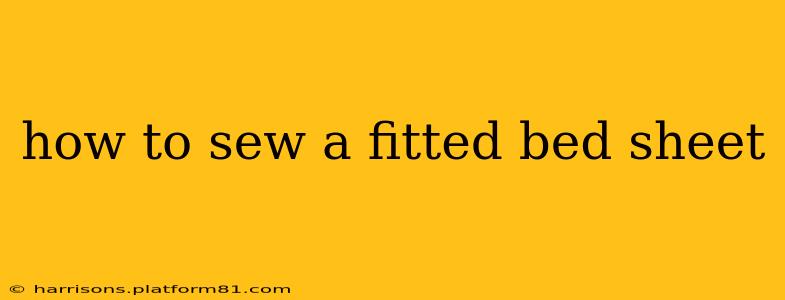Sewing your own fitted bed sheets might seem daunting, but with clear instructions and a little patience, you can create perfectly fitting sheets tailored to your mattress. This guide will walk you through the process, answering common questions along the way. This is especially useful for those with unusual mattress sizes or who want a specific fabric that's hard to find commercially.
What kind of fabric is best for fitted sheets?
Choosing the right fabric is crucial for comfort and durability. Percale, a tightly woven cotton, is a popular choice for its crispness and breathability. Flannel offers a cozy warmth for colder months. Other options include jersey knit (for a softer feel), linen (for its durability and breathability), and even blends like cotton-polyester for wrinkle resistance. The best fabric depends on your personal preference and climate. Consider factors like thread count and weight for optimal comfort and longevity.
How do I measure my mattress for a fitted sheet?
Accurate measurements are paramount to a well-fitting sheet. You'll need to measure the length, width, and depth (height) of your mattress. Use a tape measure and ensure you measure at multiple points to account for any inconsistencies. Add extra fabric to account for seam allowances and stretch. A common recommendation is to add 2-4 inches to both the length and width and at least 6-8 inches to the depth, ensuring that the finished sheet fits snugly, without pulling or stretching excessively.
What materials will I need to sew a fitted bed sheet?
Besides your chosen fabric, you'll need:
- Scissors or rotary cutter: For precise fabric cutting.
- Pins: To hold the fabric together before sewing.
- Sewing machine: A reliable sewing machine is essential, though you could hand-sew a very small sheet.
- Thread: Choose a strong thread that matches your fabric color.
- Measuring tape: Accurate measurements are crucial for a proper fit.
- Iron and ironing board: To press seams and ensure a neat finish.
- Seam ripper: For correcting mistakes.
How much fabric do I need to sew a fitted bed sheet?
The amount of fabric depends on your mattress dimensions and the added seam allowances. It's always best to err on the side of caution and buy a little extra. Calculating the total fabric needed involves adding the seam allowances to your mattress measurements (as discussed in the previous section), ensuring there’s enough extra to accommodate for shrinkage (especially with natural fibers like cotton) and the stretch required. A pattern or template can be helpful in precisely calculating your fabric requirements.
What is the best way to sew elastic into a fitted bed sheet?
There are a few ways to sew elastic into your fitted sheet, each with its pros and cons:
- Casings: This method involves creating a tunnel (casing) along the edges of the sheet where you insert the elastic. It's simple and relatively easy for beginners.
- Directly attaching elastic: This involves sewing the elastic directly to the edge of the sheet. This offers a more streamlined finish, but it requires more skill.
Regardless of your chosen method, ensure the elastic is the correct length and provides adequate stretch for a snug fit without being too tight. Using safety pins to temporarily attach the elastic to the sheet before sewing can simplify the process considerably.
How do I sew a fitted sheet with corners?
The corners are arguably the most crucial part of a fitted sheet. The key is creating a mitered corner – a neatly folded and sewn corner that prevents bulk and ensures a smooth, clean finish. Numerous online tutorials and videos demonstrate this technique in detail. This process uses precise measurements and involves folding and pinning the corners before sewing. Practice on scrap fabric first for a perfect result.
How to finish the raw edges of a fitted bed sheet?
To prevent fraying and ensure a professional finish, always finish your raw edges. You can use a serger (for a neat, professional look), zigzag stitch (a basic sewing machine stitch), or even a simple overcasting stitch done by hand. Choosing the right edge finishing technique depends on your machine capabilities and the fabric type.
Creating a perfectly fitting fitted sheet requires patience and attention to detail, but the satisfaction of crafting something beautiful and functional for your bedroom is immensely rewarding. Remember to always measure accurately, choose your fabric carefully, and follow the steps methodically. Happy sewing!
